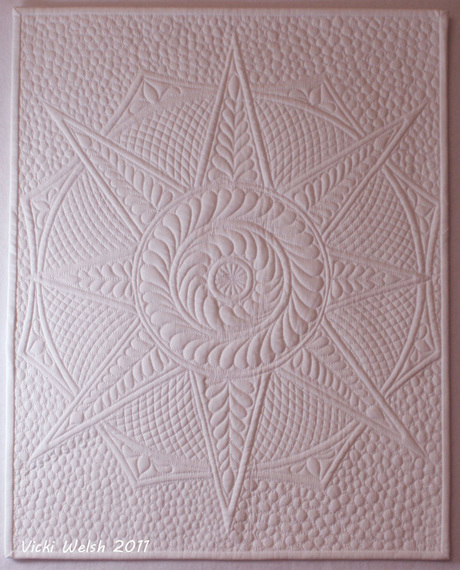Fiberactions Challenge Quilts
In 2008 I learned Paula Nadelstern's kaleidoscope technique and fell in love with it. In 2010 I was invited to join an art quilt group called Fiberactions. We created pieces every other month and they were all 16" x 20". Each challenge had a theme word and we could create whatever we wanted. I chose to use this challenge to experiment with symmetry techniques. The challenge continued in 2010. Check that Gallery for the rest of the entries. Some of these quilts have been exhibited at the Virginia Quilt Museum in September 2011.
There should have been 6 quilts in the series for this year but I seem to remember that the group fizzled out before finishing out the year.
There should have been 6 quilts in the series for this year but I seem to remember that the group fizzled out before finishing out the year.
|
Environment- January - This is the 6th in the Fiberactions challenge series. This is actually my first full kaleidoscope in the series. I really enjoyed making it. As I said on the Fiberactions post, I was making this one to look less like a star (with sharp points) and more like a flower blooming
This kaleidoscope is made up of 8 wedges. Each wedge is made completely and then the wedges are sewn together. This is a close up of one wedge with the seam lines highlighted. There are 30 individual pieces of fabric in each wedge, 240 in the whole kaleidoscope.
After I finished it I just couldn't love the 16 x 20 format. I posted it in this format on the Fiberactions blog but, after pondering it a bit, I turned it into a pillow!
Impression - March - This is the 7th in the Fiberactions Challenge series. This one really showed me how important it is to develop a series - whether it's series of art or just a series of lessons. Several ideas and techniques that I have been exploring came together on this one. Of course I had to keep with my underlying technique for the whole series, symmertry. But with this theme I wanted to see how subtle the symmetry could be. I thought about archaeology and how difficult it must be to find anything while sifting and digging through mounds of dirt. Everything must seem to look the same. I eventually settled on a fossil-like image. I consider this one a "fix" of the Stretch Challenge because I used a similar technique....but in a better way.
|
Embellish - July - The subtitle of this one should be "struggle". This is the first theme word that we've had that was a verb. I don't know why but it really threw me. I didn't want to just make another kaleidoscope and embellish it. So I converted the word to a noun: embellishment.
em·bel·lish·ment/emˈbeliSHmənt/Noun1. A decorative detail or feature added to something to make it more attractive: "architectural embellishments". So, what is a quilt embellishment? It's anything really. Of course, beads, yarns, crystals, foil and paint all come tom mind. But what's the most basic embellishment? Thread. But is color also an embellishment? I think so and that's how I wound up doing a quilt with only one embellishment: white thread. Hence, a whole cloth kaleidoscope.. Not once during the past year and a half did I ever consider that I would do a whole cloth quilt for one of the challenges but this was perfect for me. I believe it meets the theme and it also introduced another new skill for me. This is my first ever whole cloth quilt! It's also the first feathered wreath motif that I've quilted and been reasonably satisfied with.
Two other firsts include doing vast amounts of pebbling and serious curved cross hatching. Both, it turns out, are reasonably easy to master.
When the theme word was published 2 months ago, my first inclination was to "depart" from my symmetry theme. I considered it but I just couldn't because I am enjoying working with symmetry and I don't want to depart it! So, I started reviewing some of the other techniques within symmetry that I have been wanting to try.
For this challenge I chose to explore bilateral (horizontal and vertical) symmetry as a departure from the traditional kaleidoscopic approach that I have been taking. I added a twist by throwing in a limitation. Every piece of fabric is a 3" equilateral triangle. That made it difficult to find patterns on the fabrics that would blend into 2 neighboring fabrics, but using bilateral symmetry at least made one side easy! I did some pretty heavy quilting on this one using metallic and rayon threads to help blend the transitions between fabrics. Aesthetically it's not one of my favorites in the series but from a skill development point of view, it's one of the best!
|








